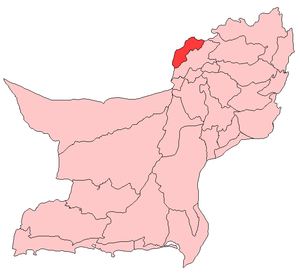Killa Abdullah District
| Killa Abdullah District | |
|---|---|
| District | |
 Map of with Qilla Abdullah District highlighted | |
| Country | Pakistan |
| Province | Balochistan |
| Division | Quetta Division |
| Established | 1993 |
| Headquarters | Chaman |
| Government | |
| • Deputy Commissioner | Muhammad Asghar Harifal |
| Area | |
| • Total | 3,293 km2 (1,271 sq mi) |
| Population (1998)[1] | |
| • Total | 370,270 |
| Time zone | PST (UTC+5) |
| Number of Tehsils | 4 |
Killa Abdullah or Qilla Abdullah or Abdullah Qilla (Pashto: قلعہ عبد الله) is a district in the north west of Balochistan province of Pakistan. Killa Abdullah was separated from Pishin District and made a new district in June 1993.[2]
The population of Qilla Abdullah District was estimated to be over 120,000 in 2012, the vast majority being Pakhtuns. 99.5% of the people of the area are Muslims.[3] Pashto is the first language of 97.5% of the population.[4]
Topography
Qilla Abdullah district lies between 30 - 04 ' to 31 - 17 ' North Longitude in the foothills of the Shela Bagh Mountain range. It is bordered by Pishin District in the east, Quetta District in the South and by Afghanistan in the west. The geographical area of the district is 5,264 km2. It is composed of two sub-divisions; Gulistan and Chaman. The general character of the district is mountainous. Its northern area is covered by the Toba Plateau. The hill ranges are fairly uniform in character. They consist of long central ridges with numerous spurs. These spurs vary in elevation from 1,500 to 3,300 meters.
Soil
Qilla Abdullah is a small valley bordered by mountains. The valley floor is covered with unconsolidated alluvial sediments that are mostly composed of clay, silt, silty clay and clayey silt. All these sediments were deposited in the valley by the seasonal streams that flow across the valley (generally north to south). The soil is of loamy nature in the Gulistan area, while the soil of Tehsil Chaman is sandy clay - gravial (Admixture). The sandy fraction increases towards the mountain ranges. The scarcity of water in the area and the semi-desert climatic conditions have limited trees and shrubs to grow.
Climate
The climate of the district Killa Abdullah is generally dry and temperate. The adjoining districts have somewhat deviating temperatures, owing to different elevations. The climatic conditions of the district are particularly suitable for horticulture/ agriculture. The climate is especially suitable for the growth of fruits e.g. apples, apricots, peaches, plums, grapes, cherries and vegetables such as potatoes, onions, tomatoes.
History
In 1839, this area along with Quetta and Pishin region became a part of British India as a result of the First Anglo Afghan War.[5] However, in 1842, the Afghans reoccupied the entire Pishin Valley, losing it again in 1879.[5] Four years later, Pishin and the surrounding areas were merged with Quetta district.[5] In 1993, it was separated from Pishin for administrative reasons and was given the status of a district.
Administrative subdivisions
The district is administratively subdivided into the following tehsils:[6]
Sites of interest
References
Bibliography
- 1998 District census report of Killa Abdullah. Census publication. 121. Islamabad: Population Census Organization, Statistics Division, Government of Pakistan. 2000.
External links
| Wikimedia Commons has media related to Killa Abdullah District. |
- Killa Abdullah District at www.balochistan.gov.pk
- Killa Abdullah District at www.balochistanpolice.gov.pk
Coordinates: 30°36′43″N 66°34′34″E / 30.612°N 66.576°E
